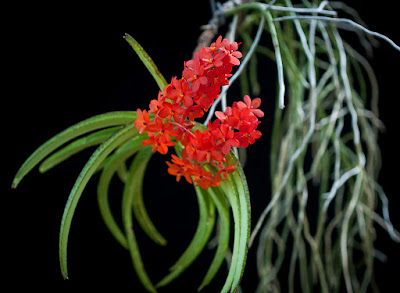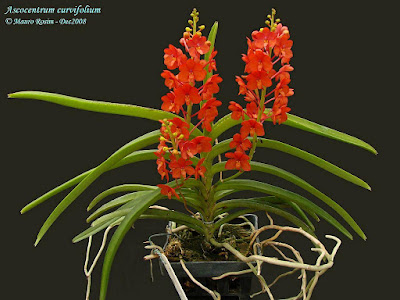Ascocentrum curvifolium is native to Assam India, eastern Himalayas, Nepal, Myanmar, Thailand, Laos, southern China and Vietnam to the south. In Myanmar, this orchid is found along the Attran River in Tenasserim, near Moulmein and near Tavoy. In Thailand, its distribution is basically limited to deciduous forests in the mountains along the Burmese border, in the north and in the west of Thailand.
Ascocentrum curvifolium, also called as The Curved Leafed Ascocentrum, Gastrochilus curvifolius, Saccolabium curvifolium, Saccolabium curvifolium var. luteum, Saccolabium miniatum, Vanda curvifolia, is a species of the genus Ascocentrum. This species was described by (Lindley) Schlechter in 1913.
IDENTIFY ASCOCENTRUM CURVIFOLIUM
Ascocentrum curvifolium is native to Assam India, eastern Himalayas, Nepal, Myanmar, Thailand, Laos, southern China and Vietnam to the south. In Myanmar, this orchid is found along the Attran River in Tenasserim, near Moulmein and near Tavoy. In Thailand, its distribution is basically limited to deciduous forests in the mountains along the Burmese border, in the north and in the west of Thailand.
It is a small to medium sized, hot to warm growing epiphyte with short, often bifurcate, stout, woody below stems covered by leaf bases carrying distichous, narrowly linear, strongly decurved, praemorsa or bidentate apically leaves. The leaves are 10-15 cm long, less often 25 cm long and 1.0-1.5 cm wide. They are light green with purple spots along the banks, which are especially visible in the summer.
The Curved Leafed Ascocentrum blooms in the late spring and summer on a crowded, erect, 6 to 10" (15 to 25 cm) long, axillary, shorter than the leaves, densly many flowered inflorescence. The flowers have a diameter of 2.0-2.5 cm and usually last for 2-3 weeks. Egg-shaped petals can be any shade from dark orange to cinnabar-red. The lip is elongated, similar to a tongue, on the sides of its base there are two thickenings of yellow color. The column is cinnabar-red with a purple cap covering the anther.
ASCOCENTRUM CURVIFOLIUM CARE AND CULTURE
Cultural information should only be used as a guide, and should be to be adapted to suit you. Your physical location; where you grow your plants, how much time you have to devote to their care, and many other factors, will need to be taken into account. Only then can you decide on the cultural methods that best suit you and your plants.
Light:
Ascocentrum curvifolium needs a light level of 25000-35000 lux. This species grows better in moderately bright scattered light, it can not be exposed to direct sunlight. A constant ventilation is necessary.
Temperature:
The plant is thermophilic. In summer the average day temperature is 31-32 ° C, at 23-24 ° C during the night, which gives a daily difference of 7-9 ° C. The average temperature of such a spring day is 34-36 ° C, the night 17-23 ° C, and the daily span diminishes from 18 to 11 ° C. In winter, the average day temperature is 29-32 ° C, night 13-14 ° C, with a daily amplitude of 15-18 ° C.
Humidity:
Ascocentrum curvifolium needs the humidity of 80-85% in summer and early autumn, then gradually falls to almost 60% at the end of winter and early spring.
Substrate, growing media and repotting:
The Curved Leafed Ascocentrum can be mounted on cork or tree fern rootstock if you can provide high humidity, daily watering in the summer and in hot and dry weather, watering is even several times a day. The plants can also grown in pots or baskets with a very loose, quick-drying substrate, such as pieces of medium-sized bark with the addition of pearlite and charcoal.
These plants are particularly sensitive to degraded soil around the roots, so they should be repotted immediately, when the substrate begins to decompose. Repotting should be carried out when new roots begin to appear, because the plant will be accepted and rooted in the shortest possible time.
Watering:
In the period from late spring to autumn, Ascocentrum curvifolium should be abundantly watered, but their roots must dry quickly after watering, and the ground around them must never be spread or soggy. When new growths reach maturity in the autumn, the amount of water should be gradually reduced.
Fertilizer:
In the period of active growth, plants are given weekly 1/4-1/2 of the recommended dose of fertilizer for orchids. You can use a balanced fertilizer all year round, and you can use a fertilizer with a high nitrogen content from spring to mid summer, and from mid-summer and fall - a fertilizer with a high content of phosphorus.
Rest period:
A cool, dry resting period in winter is necessary to induce flowering. In winter, Ascocentrum curvifolium need less occasional morning fogging between occasional light watering. Between plants, the plants should dry out, but they should not be completely dehydrated. However, in late winter or early spring, for about a month, water supply should be limited to occasional light fogs early in the morning. Fertilization should be eliminated until new growths appear and more watering begins in the spring.















COMMENTS